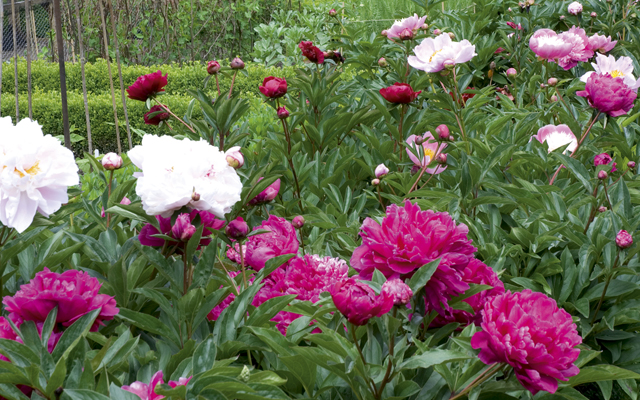How to plant peonies
Alan Titchmarsh couldn't have a garden without peonies.


I’ve lost count of the number of times I’ve been asked to recommend a garden plant that is evergreen and will flower all the year round. In mischievous mood, I’m tempted to suggest gorse. ‘When gorse is in bloom, kissing is in season’ goes the old saw. The country folk of yore were more observant than the townies of today, as they knew that the spiky bush is seldom without at least one or two of those bright yellow flowers that are scented so deliciously of coconut.
However, the truth of the matter is that flowers that bloom all the year round would quickly pall. We need variety in our gardens and, for me, our cool, temperate climate, with its endless seasonality, is a rich blessing.
At the opposite end of the flowering spectrum are beauties that have but a single, spectacular season. For me, they are prized treasures, not to be spurned, but to be anticipated eagerly, as although they may bloom only fleetingly, they are all the more appreciated. These firework plants are the leavening of the loaf, a fleeting treat without which life would be all the poorer.
An accusation frequently directed at peonies, for example, is that their flowering season is too brief. I have friends who will have no truck with them, saying that, for all their spectacle, their season of beauty is so short as to be laughable. Oh, but a late spring without Sarah Bernhardt in her soft, double-pink glory that is the floral equivalent of Fragonard’s The Swing, Coral Sunset with its astonishing salmon-pink goblets or Bowl of Beauty, a nest of creamy white icicles held in a dish of pink, would be a poorer season.
There are rich-crimson peonies and there are those of pure white. There are singles with a central boss of gold or cream and others that are so double the petals seem impossible to count. Plant them where they can show off when in bloom and where other plants will make up for their dullness when the blooms fade and you can mask their deficiencies without depriving yourself of their Maytime delight.
Not that growing peonies is always easy. It can be, but you need to remember one or two important requirements. The most critical of these is planting depth. When committing a pot-grown peony to the earth, on no account bury it too deeply, for to do so will surely deprive you of flowers for many a year. The yam-like roots (massive, sweet-potato lookalikes) need to be only fractionally below the surface of the soil.
Next, don’t feel that you have to dig them up and divide them every three or four years as is the case with many herbaceous perennials. Peonies love lazy gardeners who leave their clumps alone, to fatten and grow more generous with the years.
Exquisite houses, the beauty of Nature, and how to get the most from your life, straight to your inbox.
Peonies are not especially demanding when it comes to growing conditions, asking only for a spot in full sun and well-drained soil. A sprinkling of rose fertiliser in March will encourage them, along with a mulch of well-rotted manure or garden compost, and then, in April, when their almost prehistoric-looking shoots of red and maroon start to push up from the soil, you can wait with bated breath to see how many flowers they will produce.
They will also appreciate some support in the form of circular wire grids on legs, placed over the shoots when they’re 6in high so that the wire circle itself sits about 1ft above the ground. Soon, the shoots will grow through the supports and the leaves will mask the framework.
Pests and diseases? There are assorted blotches and blights — grey mould (botrytis) is the one most likely to be a pain — and ants will clamber over them in search of sticky honeydew. But if the plants are grown well in the airy, sunlit conditions they like, then neither of these problems should pose a great long-term threat.
And if you really can’t come to terms with the short flowering season, do as I do and grow peonies in rows on the veg patch for cutting. Walking back to the kitchen with an armful of blooms is the most extravagant feeling of all.
My Secret Garden by Alan Titchmarsh is published by BBC Books (£25)
How to grow fritillaries
Botanical artist and Fritillaria specialist Laurence Hill reveals his top tips.
Country Life is unlike any other magazine: the only glossy weekly on the newsstand and the only magazine that has been guest-edited by His Majesty The King not once, but twice. It is a celebration of modern rural life and all its diverse joys and pleasures — that was first published in Queen Victoria's Diamond Jubilee year. Our eclectic mixture of witty and informative content — from the most up-to-date property news and commentary and a coveted glimpse inside some of the UK's best houses and gardens, to gardening, the arts and interior design, written by experts in their field — still cannot be found in print or online, anywhere else.
